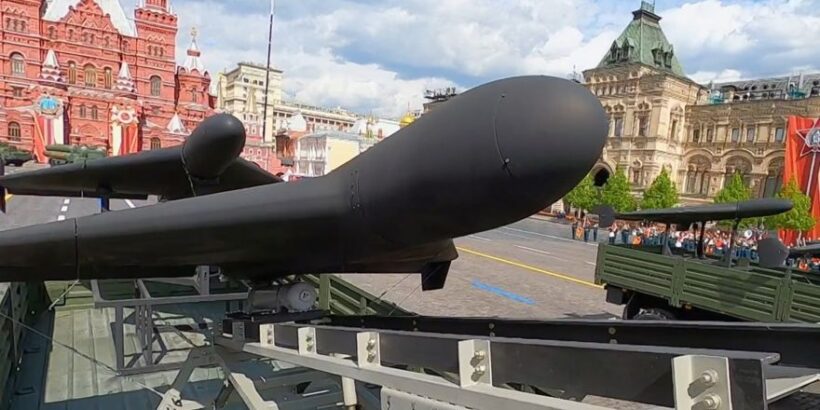The guided loitering munition ‘Geran-2’ was first publicly displayed at the Victory Day Parade on 9th May 2025. This kamikaze drone is equipped with a piston engine, providing a speed of up to 200 km/h. The UAV’s length is 3.5 metres, with a wingspan of 2.5 metres. The take-off weight is approximately 250 kg, of which 50 kg is the warhead. The flight range reaches 1,000 km, and the endurance is up to 6 hours.
As a result of operational experience gained from the combat use of the ‘Geran-2’ UCAV against military and energy infrastructure targets in Ukraine, the munition has been upgraded. The warhead weight has been increased to 90 kg, replacing the high-explosive charge with a high-explosive fragmentation incendiary (HE-FRAG-I) charge, which has improved the destructive effect. The range has decreased as a result, but optimisation of the fuel system has allowed for a saving of 14 litres of fuel and an addition of 140 km to the range, which now stands at 650 km. To counteract electronic warfare (EW), the drone has been ‘taught’ to recognise areas of satellite signal jamming. According to open-source information, some units have received thermobaric warheads, which are effective against fortified targets.
The tactics for the use of the ‘Geran-2’ UCAV involved massed attacks using several dozen, and sometimes hundreds, of drones simultaneously. This overloaded the enemy’s air defence system and ensured the destruction of intended targets by both the ‘Gerans’ themselves and high-precision guided weapons. Ukrainian Telegram channels reported that in 2024, the Russian army used up to 500 ‘Geran-2’ drones per month, and from January 2024, they reported the use of the ‘Geran-3’ jet-powered UCAV by the Russian military.
It is believed that this kamikaze drone is a further development of the ‘Geran-2’ platform and differs in that it has a turbojet engine instead of a piston engine. There has been no official confirmation from the Russian Ministry of Defence regarding the existence of a jet-powered loitering munition in the Russian army’s inventory. However, the specifications of the aircraft, based on reports from both Ukrainian and Russian military bloggers, are worthy of note.
Ukrainian Intelligence Claims “Mopeds” over Kyiv and Odesa are Flying Faster
The turbojet engine with a thrust of approximately 120-125 kgf allows the ‘Geran-3’ UCAV to reach speeds of up to 600 km/h. The flight endurance is up to two hours, with a maximum range that cannot exceed 1,200 km, although some sources report 2,500 km. The warhead weight has increased to 300 kg – six times that of the ‘Geran-2’, and the overall weight of the drone has increased to 1,000 kg. It is believed that the ‘Geran-3’ is equipped with modern guidance systems, including a multispectral electro-optical seeker head operating in the mid- and long-wave IR bands, as well as possible options with infrared (IR) sensors or passive radar homing.
According to Ukrainian intelligence (GUR), Russia has already established serial production of the ‘Geran-3’. Some experts believe that it is a version of the Iranian Shahed-238 strike UAV adapted to Russian requirements, but there is no direct confirmation of this. The main difference of the ‘Geran-3’ is its speed. In addition, the drone is designed using low-observable technologies – its radar cross-section (RCS) does not exceed 0.05 m². These factors make interception difficult and require the use of more expensive surface-to-air missiles (SAMs).
Disadvantages of the ‘Geran-3’ include the hot exhaust of the jet engine, which increases its visibility in the infrared waveband, making the UCAV vulnerable to rear-aspect attacks by missiles with IR homing. Another drawback is the high production cost due to the complex engine, which may limit the possibility of launching massed strikes with this drone, or require the development of new tactical approaches to its use.
The Russian military has used the ‘Geran-3’ to strike military targets in Ukraine, including defence industry facilities. On 24th April 2025, ‘Geran-2’ and ‘Geran-3’ drones attacked the ‘NII Storm’ factory in Odessa, where electronics were being assembled for Ukrainian drones. According to Ukrainian monitoring groups, Russia launches strike drones in swarms and combines ‘Gerans’ with other UAVs, including decoy types such as ‘Gerbera’ and cruise missiles.
Thus, the low-observable loitering munition ‘Geran-3’ has achieved operational readiness and possesses combat capability comparable to a cruise missile, allowing it to attack fortified targets, including bunkers, command centres and industrial buildings throughout Ukraine. Its capabilities are significantly expanded compared to the previous model.


